Pakistan is a land of color, scent, and friendly people, so it’s no surprise to discover the richly scented national flower of Pakistan is jasmine.
This beautiful, highly fragranced, and easy-to-grow plant is common across Asia’s wild and cultivated spaces. You may already have it growing in your yard too because it’s popular worldwide for its incredible scent and ability to cover a wall in double quick time.
Let’s discover the national flower of Pakistan: jasmine.
What’s Pakistan’s National Flower?
Pakistan’s national flower is jasmine. It’s a highly scented delicate-looking white flower on a tall vining shrub and part of the olive family. It’s a frequent sight in Pakistan, and naturalized in many other places including Europe, the Americas, and Oceania.
Jasmine is called Chambeli in Pakistan and was chosen to be the national flower of Pakistan on July 15, 1991.

The national flower of Pakistan is jasmine.
©Shaikh Kamal Uddin Khalid/Shutterstock.com
Pakistan: Location and Geography
Pakistan is officially called the Islamic Republic of Pakistan. It’s located in South Asia and borders India, Afghanistan, Iran, and China with a 1,046-kilometer coastland on the Arabian sea. There are 243 million people in Pakistan and Karachi is its capital city.
It has six UNESCO World Heritage sites including the archaeological site of one of the world’s earliest major cities that dates from 2500 BCE, and Shalamar gardens which were built during the Mughal Empire of the 1600s. Shalamar gardens are Persian paradise gardens and include masses of the national flower – jasmine!
Did you know the name Pakistan derives from two Persian words? Pak for holy and stan for place = Holy Place.
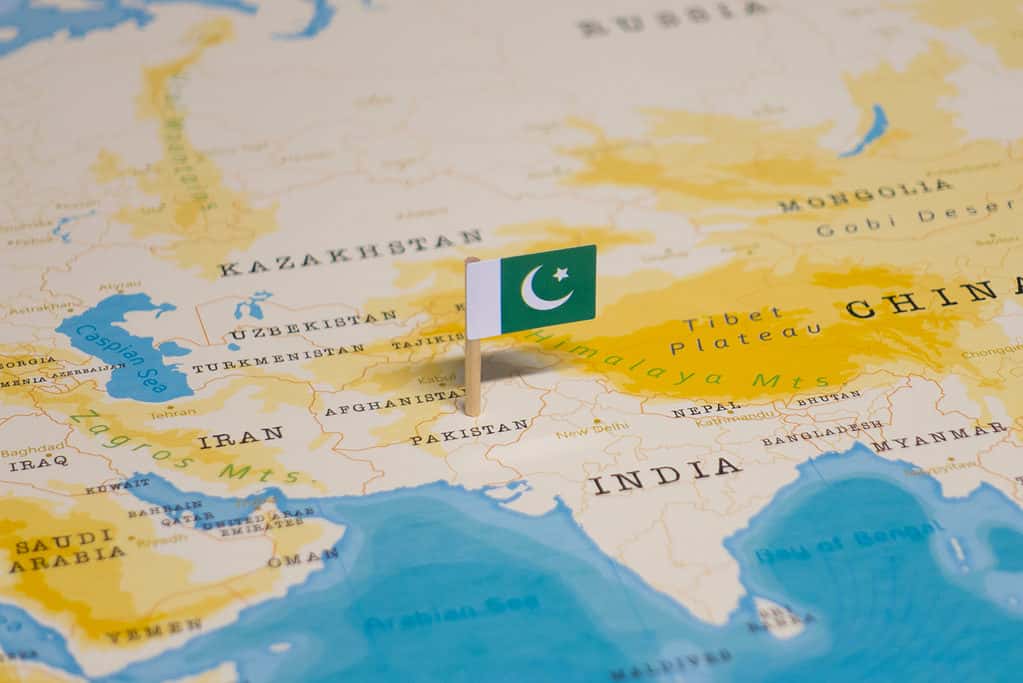
Pakistan is located in South Asia and borders India, Afghanistan, Iran, and China
©hyotographics/Shutterstock.com
Why is the National Flower of Pakistan Jasmine?
Jasmine is the national flower of Pakistan because it is so prevalent there and because it represents their values of connection, friendliness, and humility.
Jasmine is used to honor the gods and the dead in ceremonies and it’s worn as a protective charm in gajra garlands. Modern Pakistanis use traditional jasmine at weddings, where the bride and groom wear jasmine garlands, and even at school fetes. If there’s something social to celebrate in Pakistan, jasmine is always on display.
Jasmine is a popular flower in Pakistan, but it’s also the national flower of Tunisia, Africa. You can never have too much jasmine!
All about Jasmine
The name jasmine is Persian “Yasmeen” which means “gift from god” due to its intoxicating scent.
It’s native to the Himalayas and China, but has naturalized in Pakistan over thousands of years. There are over 200 jasmine species and many more cultivars created by plant breeders.
Jasmine is a night-blooming flower that releases its fragrance at night. The drop in temperature stimulates jasmine flowers into opening, which allows more scent to spread and attract pollinators such as moths.
Jasmine’s bright white color also helps guide moths to their pollen. Traditional stories suggest jasmine’s small star-like flowers are a reflection of the night sky!
Jasmine is a beautiful garden plant that supports pollinators, but it’s also used in industry. Jasmine oil is extracted for cosmetics, perfumes, sedatives, aphrodisiacs, and medicine.
Recent studies indicate jasmine may help treat liver disease, gastric illness, and even cancer. This study shows jasmine oil helped fight lung cancer cells. Lung cancer is the leading cause of cancer-related death worldwide, so this is very welcome research.
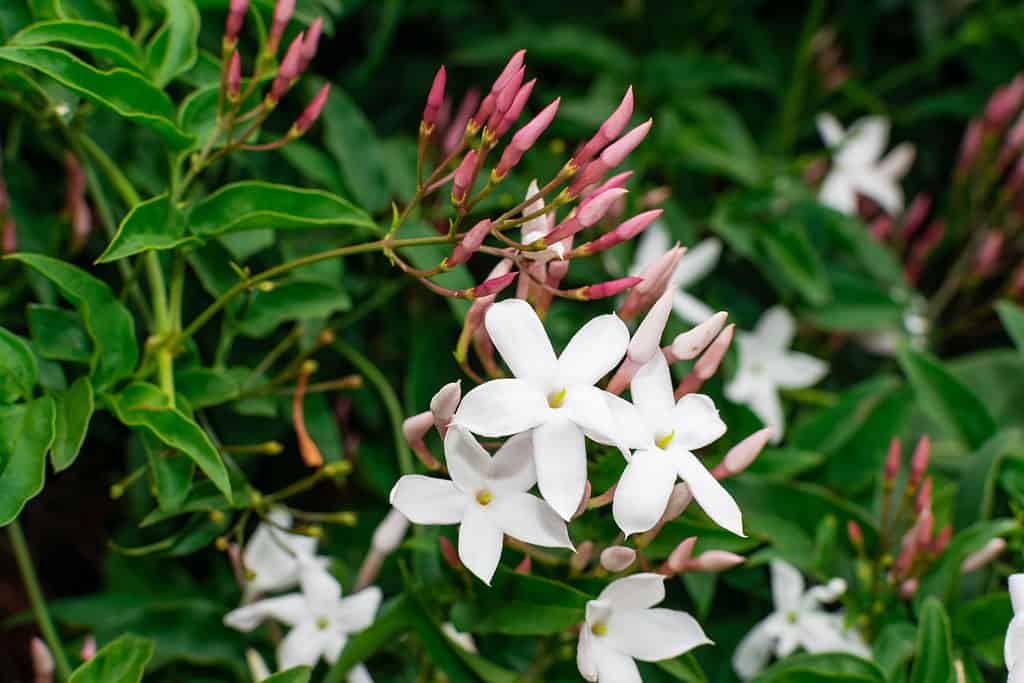
The name jasmine is Persian “Yasmeen” which means “gift from god” due to its intoxicating scent.
©Martin Leber/Shutterstock.com
Is Jasmine Native to Pakistan?
Jasmine is native to the Himalayas and China, so yes, it’s native to Pakistan’s Himalayan regions.
Is Jasmine Evergreen?
It depends.
Some species of jasmine like the star jasmine (Trachelospermum jasminoides) are evergreen and they keep their leaves all year round. Evergreen jasmines are perfect for greening up a wall or an ugly old tree stump.
Deciduous species such as common jasmine, (Jasminum officinale) lose their leaves in fall and regrow them in spring. They are generally hardier and better for cooler zones.
More on growing jasmine later!
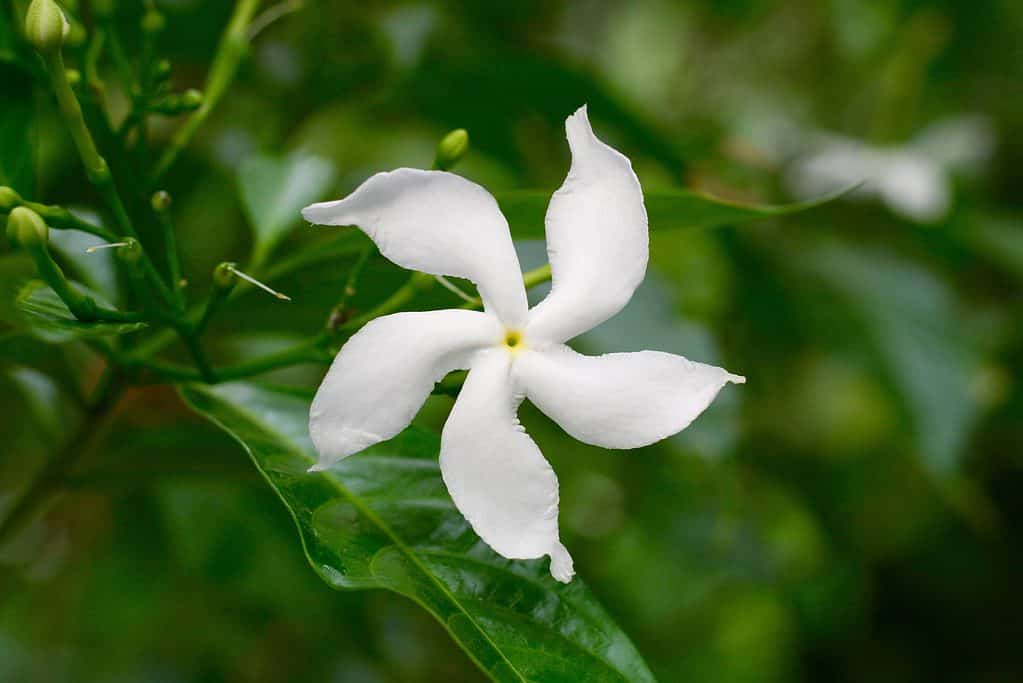
Star jasmine (
Trachelospermum jasminoides) is an evergreen species of jasmine that keeps its leaves year-round.
©maerzkind/Shutterstock.com
Do Jasmine Flowers Smell Sweet?
Yes! Jasmine flowers are deliciously sweet and heady. Pakistanis call jasmine “queen of the night” because it’s night time fragrance is so strong.
Jasmine flowers in late spring and summer, so it’s an excellent choice around seating areas and windows.
But wait!
Here’s another plant very similar to the jasmine species. It’s called Gelsemium sempervirens or false jasmine, jessamine or woodbine.
It’s a twining vine similar to jasmine, but part of the Gelsemiaceae family and native to tropical America.
False jasmine can have white, yellow or pink flowers and it releases a similar scent, but unlike true jasmine, it’s toxic if eaten and a potent skin irritant.
Despite this, jessamine is a popular plant in America and yellow jessamine is the state flower of South Carolina.
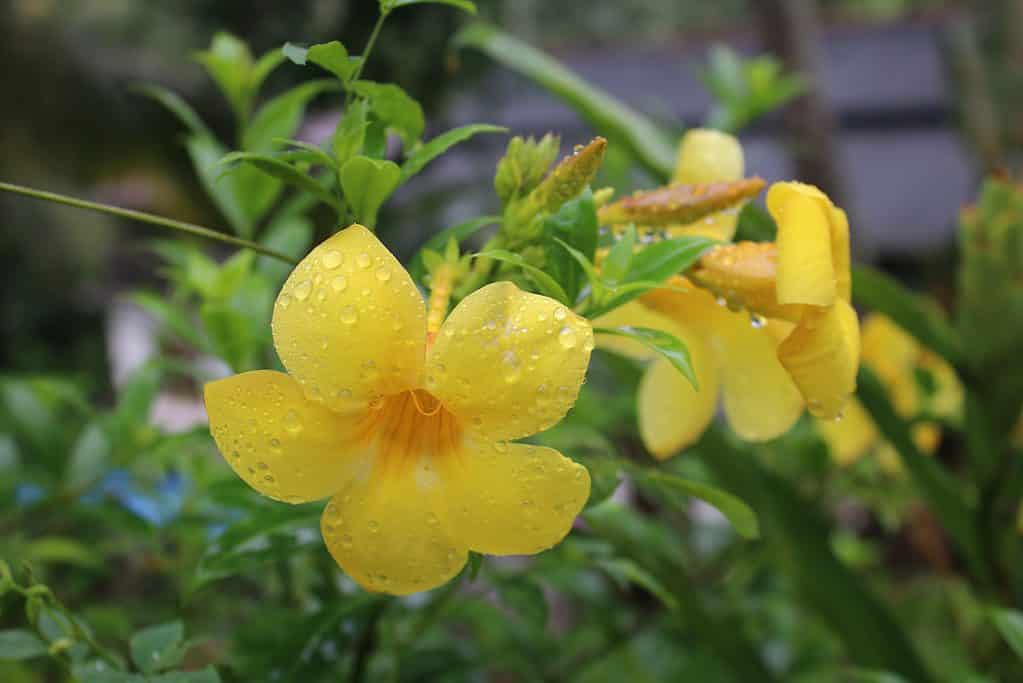
, or false jasmine, can have white, yellow or pink flowers and releases a similar scent to true jasmine.
©Low seen/Shutterstock.com
How Big Does Jasmine Get?
Jasmine is a large, quick-growing vine if it’s left to its own devices. It can reach 10-15 feet long, spread eight feet wide, and pack on 24 inches a year!
It’s totally possible to prune it back to a manageable size. Don’t let the rapid growth potential put you off the national flower of Pakistan.
Is it Toxic?
No, jasmine is not toxic to humans, and the ASPCA reports it’s not toxic to dogs, cats, or horses.
However, it pays to be wary, because as we’ve seen false jasmine is toxic.
How To Easily Grow Jasmine
Fancy the national flower of Pakistan in the yard? Good choice!
Jasmine has pretty star-shaped flowers and knockout scent, but be calm when purchasing! Some are tender and only suitable for greenhouses and conservatories.
Check the label and USDA Growing Zone to make sure your jasmine will survive. If in doubt, go for common jasmine. It’s deciduous and hardy from Zone 6 and up.
Here’s how to plant and care for jasmine
- Choose a moist, but well-drained position
- Ensure the position gets plenty of sun. Jasmine won’t flower well without several hours of sunshine a day
- If you live in a hot Zone (9-11) jasmine grows best in the morning sun, but in afternoon shade
- Erect a sturdy trellis or attach wires to the fence. Jasmine needs strong support to cling to because it’s heavy when the foliage emerges
- Dig a hole twice as wide as the root ball
- Ensure the hole matches the depth of the nursery pot. If jasmine’s stems are buried, they will rot
- Put lots of slow-release fertilizer in the hole
- Place your jasmine in, tilting it towards the trellis or wire support
- Backfill the hole with nutrient-rich soil
- Cover the roots with broken pot shards or an organic mulch like wood chippings to cut down weed competition and trap moisture
- Water it well straight away and keep watering until you can see new growth
- Jasmine needs lots of fertilizer, it’s a hungry plant that grows quickly. In summer, feed it regularly
- After it’s finished flowering, cut it back to your required height. Don’t be shy! Jasmine regenerates at a fast pace. Keep an eye out for nesting birds when you prune because they enjoy the dense foliage of jasmine plants.
Jasmine will grow in a container too. You will need to water and fertilizer more often, but containers offer flexibility such as growing jasmine on a deck or patio.
If you don’t have a suitable trellis or wall, try ground cover jasmine! In Pakistan’s wild spaces, jasmine will spread across the forest floor and colonize any support it reaches.
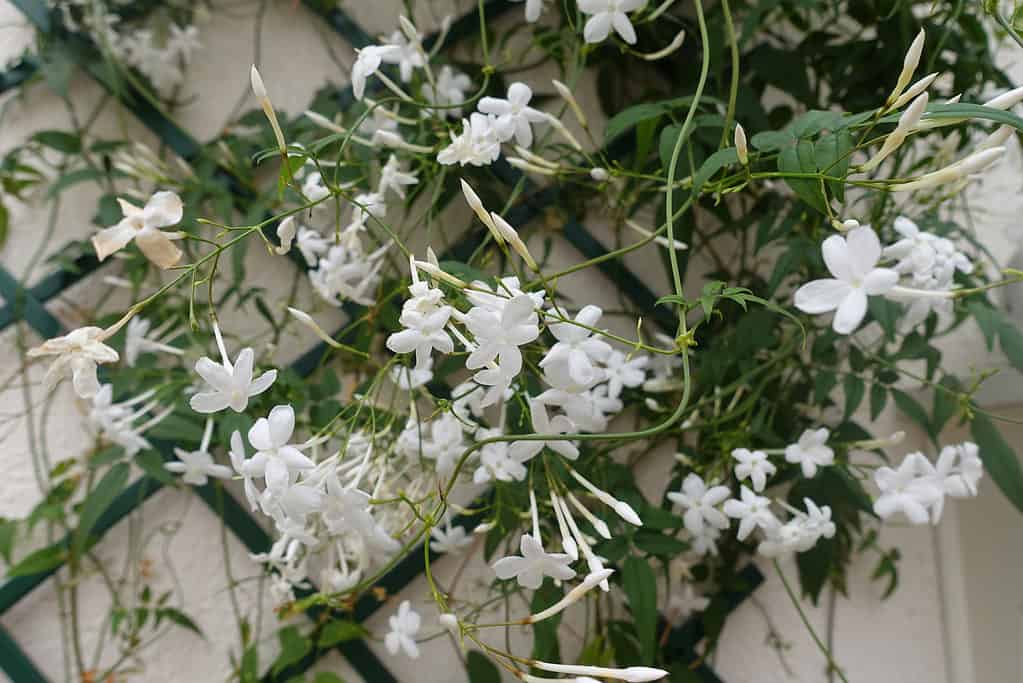
Jasmine needs strong support such as a trellis to cling to because it’s heavy when the foliage emerges.
©iStock.com/nobtis
Does Jasmine Attract Bees?
Let’s discover if the national flower of Pakistan, jasmine, will bring all the bees to your yard.
The answer is yes. Jasmine is a pollinator magnet. It will attract bees, hoverflies, butterflies, beetles and hummingbirds, but because jasmine is a night bloomer it will tempt moths too.
Moths and their larvae are eaten by bats, amphibians, nocturnal birds, spiders, lizards, skunks, and even bears! Moths are clever creatures though. A tiger moth can hear a bat’s echolocation clicks and rapidly change direction, loop, or drop to the ground to avoid detection.
In Pakistan, jasmine flowers are usually pollinated by moths and bees. There’s no arguing the fact that Pakistan’s national flower is a beautifully perfumed stand-alone ecosystem.
Up Next
- Discover the 10 Most Populated Cities In Pakistan
- The Flag of Pakistan: History, Meaning, and Symbolism
- The Chukar: National Bird of Pakistan
The photo featured at the top of this post is © guentermanaus/Shutterstock.com
Thank you for reading! Have some feedback for us? Contact the AZ Animals editorial team.






